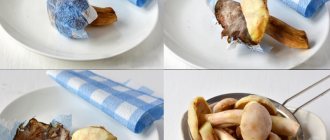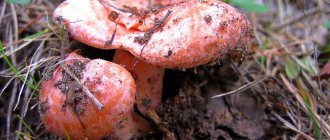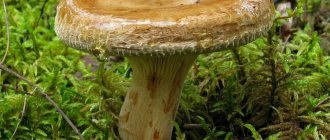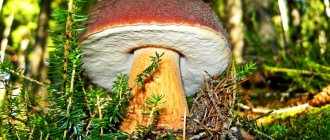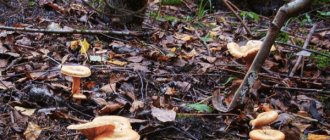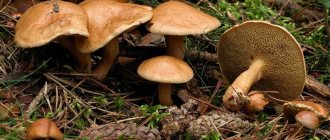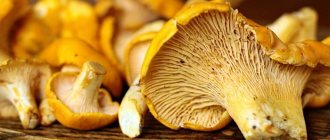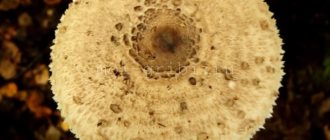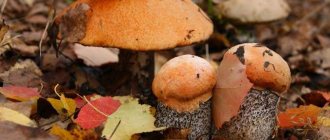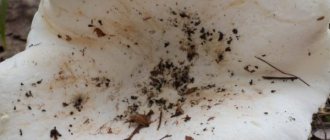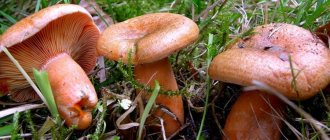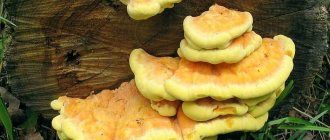Ryzhik is a special mushroom, glorified by more than one generation of lovers of traditional Russian snacks. In terms of taste and nutritional value, it is not inferior to its noble white counterpart. The saffron mushrooms (pictured) do not need a description, but it is worth reminding of what is hidden behind the red cap, recognizable by millions.
Common camelina
This is probably one of the few mushrooms to which real literary odes are dedicated. In his work “The Seventh Hunt,” the talented, original writer and poet Vladimir Soloukhin literally declares his love for saffron milk caps, sparing no compliments and literary colors.
Excerpt from the work of V. Soloukhin “The Seventh Hunt”
After such a declaration of love, you just want to go to the store and buy yourself a couple of cans of salty food. However, real saffron milk caps are prepared only at home. Where and how to collect healthy mushrooms, how to distinguish real saffron milk caps from false ones, how to prepare and preserve them - the most accurate and verified information can always be found only on the portal agronom.guru.
Since ancient times, saffron milk caps in Rus' have been considered a “smuggled-export” product. A barrel of salted or pickled saffron milk caps, along with liqueurs and stronger drinks, was taken with them to important negotiations abroad by nobles of various ranks. It is no coincidence that the second name for saffron milk cap is the royal mushroom.
Classic wild mushroom marinade
Description of the saffron mushroom
Family of saffron milk caps in a pine forest
The shape of the cap of a saffron milk cap
In order to correctly “identify” a mushroom, you should look at its cap. An “adult” mushroom can grow up to 15 cm in diameter. What does a red mushroom look like? In real saffron milk caps, the plates on the back of the cap always have a uniform orange color. When pressed, the place pressed first turns red, juice is released, which immediately acquires a greenish tint. If you cut the mushroom, the flesh is orange, but quickly oxidizes and also turns green.
True camelina plates
The shape of the camelina cap is usually flat, concave inward, the edges are slightly bent, the structure is smooth, slightly oily. The colors range from yellow to red-orange, and are characterized by cylindrical circles on the cap. Sometimes greenish-blue spots may appear on the cap when exposed to air.
Spruce saffron milk cap
The plates of saffron milk caps are usually slightly fused at first, and descending toward the stem. They always change shade when pressed to brown or green.
The size of the leg of a saffron milk cap
The leg is tubular and crumbles easily. Usually short, sometimes covered with fluff. Dense at the point of attachment to the cap, then hollow.
First aid for poisoning with false mushrooms
In case of mushroom poisoning, it is important to act immediately. It is necessary to provide the patient with medical assistance at the first symptoms of illness. Poisoning can manifest itself in different ways. Most often, the following symptoms occur in the first hours:
- abdominal pain;
- change in skin color;
- vomit;
- agitation or confusion.
Vomiting, diarrhea, nausea, hyperactivity, hallucinations, lethargy, and loss of consciousness may also begin. At the first symptoms of poisoning, the following actions must be taken:
- Call emergency medical assistance.
- Drink about 2 liters of lightly salted water to stimulate vomiting.
- Take activated carbon (1 tablet for each kg of the victim’s weight).
- Take a laxative.
After waiting for the doctors, it is important to remember what kind of mushroom you were poisoned by. This will help doctors prescribe the correct treatment.
Ryzhiki are very popular among mushroom pickers. However, inexperienced lovers of “silent hunting” may mistakenly eat the poisonous fruiting body. In case of poisoning, it is important to provide first aid to the patient as soon as possible.
Useful properties and composition
Calcium, phosphorus, potassium, vitamins A and B (riboflavin, thiamine and niacin), beneficial amino acids, anti-inflammatory and antibacterial substances - they are all contained in camelina.
The exact ratio of minerals in camelina: potassium - 397 mg, calcium - 9 mg, phosphorus - 166 mg.
The fungus contains fungin, a biologically active substance that stimulates the production of gastric juice. That is why people suffering from gastrointestinal diseases such as pancreatitis, gastritis, and stomach ulcers should stop eating saffron milk caps.
Saffron milk caps can replace a full meal
100 g of dried saffron milk caps will completely cover the daily need of the human body for meat.
Salted saffron milk cap is one of the most easily digestible foods and is superior in calories to beef and chicken.
What effect does the mushroom have on the human body?
- Increases performance and endurance. The mushroom contains a large amount of ascorbic acid, which has a tonic effect on the body.
- Creates strong bone tissue. The combination of three “building elements” of the skeleton and bones at once - phosphorus, calcium and potassium - significantly improves the condition of nails, bones and teeth.
- Antibacterial . The mushroom is saturated with a substance such as lactriviolin, a natural antibiotic that can fight such a serious infection as tuberculosis. It is from mushrooms that this substance is artificially obtained and used in the production of medicines against Koch's bacillus.
- Restores metabolic processes. Used in the treatment of skin spotting (vitiligo), rheumatism, pneumonia.
- Antitumor effect . When consumed regularly, organic saffron milk caps prevent the occurrence of cancer in the body.
Spruce saffron milk cap
In addition to its high nutritional value - saffron milk caps are considered to be the highest type of mushroom in terms of usefulness and composition, they have another very significant advantage, most often it is a pure mushroom, without rot and soil, especially if it is collected after rain early in the morning. There is no need to soak it before processing, just rinse it.
Contraindications
People with gastrointestinal problems should not eat saffron milk caps.
It is not recommended to consume saffron milk caps if:
- removed gallbladder;
- cholecystitis;
- pancreatitis;
- gastritis of any type;
- individual allergic reaction.
Unbridled eating of saffron milk caps can make defecation difficult, muscle weakness also appears, and a general decrease in performance occurs.
Salted, fried and pickled saffron milk caps become extremely high in calories, so they are excluded from the menu for those losing weight.
Where do saffron mushrooms grow?
Under what trees does saffron milk grow? You should look for “ryadovik” (another popular name for saffron milk cap) in the immediate vicinity of a pine or spruce tree; the mushroom especially loves young growth of pine trees. Most willingly, it “settles” on the edges and hills with short grass. Most often found in mixed coniferous forests of the Urals and Siberia.
The native home of the saffron milk cap is coniferous forests
True saffron milk cap always grows in “colonies”. Rest assured, if you have collected one mushroom, there is probably another one hiding next to the grass.
Fried saffron milk caps in sour cream
Until recently, I didn’t even know that saffron milk caps could be fried. It turns out, like white boletus or boletus, they can also be fried. And if you add potatoes and sour cream, the dish will turn out to be delicious!
Ingredients
- Fresh saffron milk caps – 400 g
- Potatoes – 4 medium tubers
- Onion – 1 head
- Sour cream - 2 tbsp. l.
- Butter – 50 g
- Vegetable oil for frying – 1-2 tbsp. l.
- Salt and pepper - to taste
Watch how to prepare such a simple dish in a short video.
Dear readers, if you are lucky enough to find saffron milk caps in the forest, use these recipes and pickle or pickle them for the winter. Or just fry them with potatoes and sour cream and delight your loved ones.
Bon appetit!
Main types of saffron milk caps
We have found out where the saffron mushroom grows, now let’s see what it is like. According to the place of growth, there are two main varieties of camelina - spruce and pine.
Spruce saffron milk cap
Grows in spruce forests. This variety is a medium-sized mushroom - from 2 to 8 cm. The older the mushroom becomes, the deeper the “funnel” on the cap.
Elovik
The edges of this mushroom are not curved, the stem is short. In damp weather, greenish mucus accumulates in the cap - this is a reaction of the fungal substances with the environment. Unlike the classic saffron milk cap, a much lighter yellow-gray, rarely orange, hue, the circles are barely noticeable. The taste of spruce is a little bitter.
The saffron milk caps are real
The saffron milk cap is real.
Such a “masterpiece” is difficult to miss. It looks like it was written from a picture. It is distinguished by a beautiful shiny cap in rich colors - from orange and brown to red-brown. The stem is dense, the color of the cap is even, bright red, it is slightly rounded at the edges. Grows in pine forests. Such mushrooms, as a rule, are immediately used entirely in pickles and marinades. However, to detect it, you will have to carefully examine each tubercle. The real saffron milk cap hides under a thick layer of grass and leaves. The latest mushroom of all saffron milk caps - it is collected until the end of autumn.
Red saffron mushroom
Red saffron milk cap
Not the most popular type of saffron milk cap. It is found almost in impenetrable coniferous forests. It differs in that it does not contain the mucus or milky juice familiar to other types of mushroom. It's practically dry. The leg is also different; it looks like it is covered with flour and has red spots. Quite brittle.
False saffron milk cap
Mushroom pickers insist - there are simply no false mushrooms! There are other types of mushrooms that are very similar to saffron milk caps, some of them are inedible and dangerous!
The real edible saffron mushroom exudes a pleasant smell of fresh resin in places where it breaks.
However, if you look at them more closely, they have nothing in common with real saffron milk caps.
- Inedible mushroom. It is also called amber milky. The main difference from the saffron milk cap is the leg. It is usually long, hollow and white in color. And we remember that a real saffron milk cap is usually the same color as its cap, and its stem is hollow.
Amber milkweed is an inedible mushroom, very similar to saffron milk cap.
- Death cap. It is quite easy to confuse it with a saffron milk cap - their caps are similar, but the toadstool's leg has a characteristic skirt, which a real saffron milk cap does not have.
The dangerous double of the saffron milk cap is the ubiquitous grebe
- Volnushka. The most harmless representative in this group. Volnushka does not pose any threat. However, it is still worth knowing about the difference. The edges of the waves are more rounded, in addition, they are covered with a small fluff.
Volnushka pink
You can accurately check whether a mushroom belongs to a noble family by cutting it off - if after some time the cut site turns blue or dark green, then it is a camelina.
Pine mushroom
It grows only in pine forests. Usually attached to trees or growing close to the rhizome. Unlike other varieties of saffron milk cap, it often grows alone. A characteristic feature is that they like to hide under branches or a thick layer of grass. The circles spread out in wider waves and are often uneven, oval-shaped, or even discontinuous.
The boletus mushroom loves to hide - it is better to look for it directly under the pine trees, in the grass
In the dry season there are more pine mushrooms, in rainy summers there are more spruce mushrooms.
Camelina milky red
Two-colored camelina
Thanks to its specific color, the camelina has a rather noticeable appearance. It lives in coniferous forests and ripens in late autumn. Sometimes green is also added to orange-red colors. Otherwise, it has all the other properties characteristic of saffron milk caps.
Where and at what time does it grow?
Mostly mushrooms grow in small forests, sometimes in deciduous forests if fir trees and pine trees grow in them. The mushroom can be found in groups.
Many people look for mushrooms near trees, focusing on their northern side, because they are sure that it is in these places that real delicious edible saffron milk caps grow.
Saffron milk caps appear from the end of June. Rich harvests can be harvested closer to the beginning of autumn. Mushrooms are not afraid of the first frost.
At the same time, summer harvests are watery in comparison with autumn ones, since it is in autumn that mushrooms are stronger and very tasty.
How to cook saffron mushrooms
Most often, saffron milk caps are salted or pickled. Before freezing, some mushroom pickers lightly sauté mushrooms to get rid of parasites and bacteria. The bravest summer residents even eat raw saffron milk caps, lightly sprinkled with salt.
How to salt
There are two ways to pickle saffron milk mushrooms. Consider the option of cold pickling of mushrooms.
| Photo | Description |
| To prevent the saffron milk caps from losing their beautiful color after salting and turning green, they are doused with boiling water; the steam will also kill germs. | |
| Salting of mushrooms occurs in layers - a layer of saffron milk caps, a layer of salt, and so on in turn. We take salt at the rate of 50 g of salt per 1 kg of mushroom mass. | |
| In fact, we achieve a thin, uniform layer of salt at each “level.” | |
| Before laying the first and after the last layer, you can continue the mushrooms with bay leaves and allspice. But remember, such a seasoning can completely take away the pleasant pine flavor of mushrooms. | |
| After laying the last layer, the salty mass is covered with a plate and the load is placed. Leave to cure for 4 or 5 days. | |
| After which our salted saffron milk caps are ready! |
The method is cold. This method is suitable when you are sure that your “catch” is 100% safe. In this case, heat treatment with boiling water is not allowed. The mushrooms are sorted, washed and simply covered with salt without water. In this case, scalding is prohibited, no heat treatment occurs, the mushrooms are simply rinsed, cleared of debris, and the stems are lightly trimmed. Place in a bowl with the caps down.
Saffron milk caps give juice literally after 12 hours after adding salt.
The layer should be approximately 5-8 cm wide. We traditionally sprinkle each layer with salt. Next we put oppression. After a couple of days, the mushrooms will give juice and marinate in this jelly-like mass. The consistency can be considered ready if it has been salted for at least a month.
Once upon a time there were so many saffron milk caps in the Ural forests that they were salted right there. Special cedar barrels were taken into the forest, the mushrooms were washed in the river, wiped dry, and sprinkled with salt.
How to marinate
Pickled saffron milk caps are a product of amazing taste!
Mushrooms are selected as usual, washed, the stems are cleaned, only the caps can be pickled. The prepared mushroom mass is poured with salted boiling water. Leave covered for 3 minutes. Drain in a colander, cool, and place in jars.
The next step is preparing the marinade. We take water at the rate of three-quarters of a glass per kilogram of mushrooms, add salt, spices and boil with reduced heat after boiling for about half an hour. After the marinade has cooled, add 8% vinegar, about half a glass. Pour the mixture over the mushrooms, close the jars, and place in a cool place.
Jars with saffron milk caps must be stored in a cool room with a temperature of about +15°C
Salted and pickled mushrooms love coolness. It is best to put the jars in a cellar or basement. It is necessary to check banks periodically.
How to freeze
Saffron milk caps are an excellent raw material for freezing. Moreover, you can freeze both fresh, dried and lightly fried mushrooms. The main task before freezing is to get rid of potential parasites and bacteria. How to prepare saffron milk caps for freezing? Suitable for boiling, drying or frying. As a last resort, you can wash the raw materials and pour boiling water over them. But in any case, it is important that the saffron milk caps get rid of excess moisture. For freezing, use regular bags. It is better to package the mushrooms in smaller bags in order to use exactly the quantity and volume that is needed.
Harm from saffron milk caps
Any product, no matter what it is, in addition to beneficial properties, can also have harmful ones. True, most often these harmful qualities apply only to a certain circle of people. It turns out that some people can consume this or that product, but others cannot. If it comes down to it, then fly agaric may be dangerous for some, but not for others. Same with saffron milk caps.
Since these mushrooms are highly nutritious due to the large amount of proteins, this becomes an important point for those people who have kidney or liver diseases. In addition, those who are obese should refrain from excessive consumption of saffron milk caps.
There are contraindications for consuming saffron milk caps for those who have inflammation of the pancreas or gallbladder, lack of bile secretion, gastritis, or low acidity of gastric juice.
There are some other features of consuming saffron milk caps. If you neglect them, there may be trouble.
Firstly, if you don’t know whether saffron milk caps will be good for you or not, then after eating them you suddenly experience weakness and digestive problems, you need to immediately cleanse your stomach. Exclude saffron milk caps from your diet.
You should not combine saffron milk caps with cabbage. It will be very difficult for the stomach to digest all this. Also, you should not combine it with foods that contain a lot of vitamin A. This can lead to an allergic reaction. It is not recommended for young children and pregnant women to consume saffron milk caps.
Most often, saffron milk caps are salted or pickled. At the same time, it is necessary to remember that there are practically no useful substances in salted saffron milk caps, but they are stored for a very long time, without loss of taste. Pickled saffron milk caps have the same calorie content as the marinade. Therefore, excessive consumption of such a product can lead to excess weight. The only form in which these mushrooms do not lose either their beneficial properties or taste is when frozen and dry.
And lastly. It's more of a question of picking mushrooms. Since it was previously said that saffron milk caps have doubles, among which the amber lacticaria contains some toxic substances, poisoning is possible if you confuse these mushrooms.
Symptoms of poisoning include fever, abdominal pain, gag reflex and loose stools.
If this trouble happens, there is no need to panic. It is recommended to drink plenty of water and call an ambulance immediately.
However, it is best to collect mushrooms that are known in advance. If in doubt, it is better not to touch the mushroom. Well, those that have been collected must be rechecked again and the best ones selected, without damage.
Since saffron milk caps are a food product, the question naturally arises of what and how can be prepared from them.
